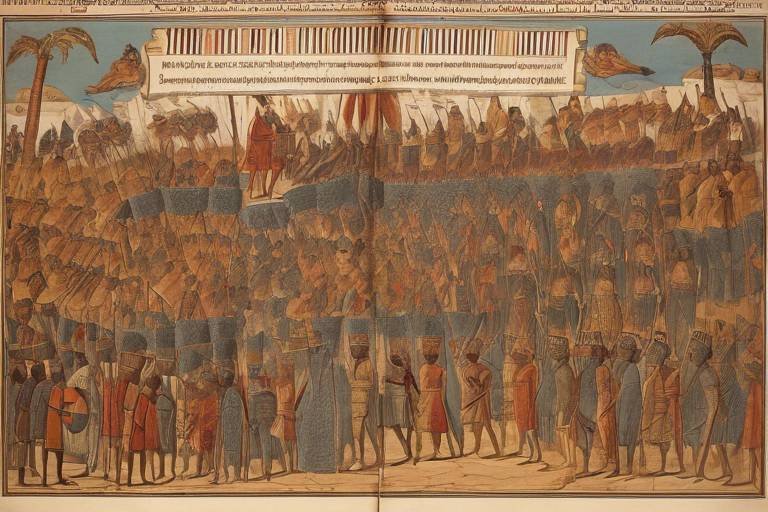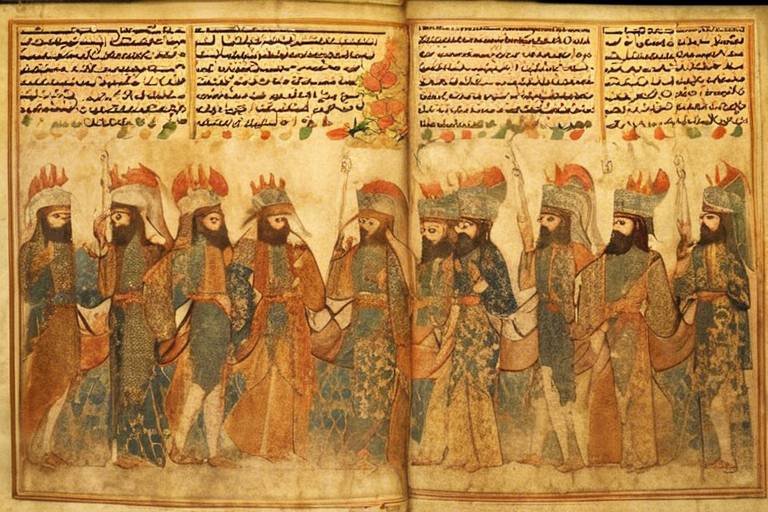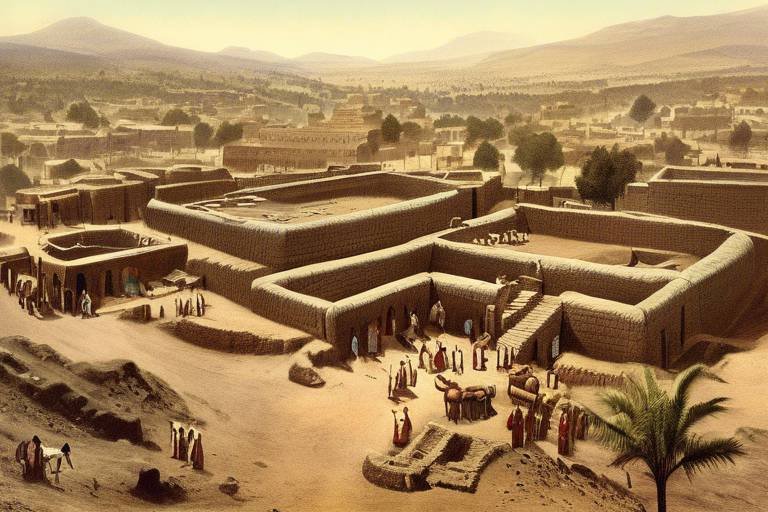The Decline of the Tang Dynasty - Historical Insights
The decline of the Tang Dynasty marks a pivotal period in Chinese history, characterized by a series of internal conflicts, external invasions, economic challenges, cultural shifts, and political turmoil. This era saw the once-mighty empire facing a multitude of crises that ultimately led to its downfall. By examining the historical insights into the decline of the Tang Dynasty, we can gain valuable lessons and a deeper understanding of the factors that contributed to the unraveling of this powerful dynasty.

Internal Strife and Rebellion
During the waning years of the Tang Dynasty, internal strife and rebellion plagued the once-mighty empire, sowing seeds of discord and chaos within its borders. Various factors contributed to these tumultuous times, leading to political instability and the gradual erosion of central authority.
One of the primary reasons behind the internal conflicts was the power struggles among the ruling elite. Ambitious officials vied for control and influence, often resorting to treachery and deceit to advance their own agendas. This infighting weakened the government's ability to govern effectively and respond to external threats.
The rise of regional warlords further exacerbated the situation, as these military commanders amassed power and resources, challenging the authority of the central government. Their rebellions not only undermined the unity of the empire but also drained its military strength, making it vulnerable to external invasions.
Moreover, economic disparities and social unrest fueled the flames of rebellion. The peasantry, burdened by heavy taxes and oppressive policies, rose up against their oppressors, seeking justice and equality. These peasant rebellions, such as the Huang Chao Rebellion, shook the foundations of the Tang Dynasty and highlighted the deep-rooted discontent among the common people.
As the central government struggled to maintain control over its vast territories, local uprisings and revolts spread like wildfire, challenging the legitimacy of the ruling regime. The weakening grip of the Tang Dynasty on its subjects paved the way for further disintegration and eventual collapse.
In the face of internal strife and rebellion, the once-glorious Tang Dynasty found itself embroiled in a downward spiral, unable to quell the unrest and restore order. The echoes of these turbulent times reverberate through history, reminding us of the fragility of power and the consequences of unchecked ambition.

Foreign Invasions and Border Conflicts
During the decline of the Tang Dynasty, external threats posed significant challenges to the empire's stability. Nomadic tribes, such as the Xiongnu and Uighurs, frequently launched invasions across the borders, putting immense pressure on the Tang military resources and defenses. These incursions not only weakened the empire's ability to protect its territories but also strained diplomatic relations with neighboring states.
Border conflicts further exacerbated the situation, as disputes over territorial claims often led to prolonged military engagements that drained the empire's resources. The Tang Dynasty found itself facing a constant struggle to maintain control over its vast borders, stretching its military forces thin and leaving vulnerable points that invaders exploited.
The impact of foreign invasions and border conflicts extended beyond military concerns, affecting the economy and social stability of the empire. Trade routes were disrupted, hindering commerce and leading to shortages of essential goods. Additionally, the constant threat of invasion instilled fear and uncertainty among the populace, further eroding the trust in the government's ability to protect its citizens.
Despite efforts to fortify border defenses and negotiate treaties with neighboring powers, the Tang Dynasty struggled to contain the external threats, ultimately contributing to the empire's gradual decline. The continuous pressure from foreign invasions and border conflicts highlighted the vulnerabilities of the once-mighty empire and played a significant role in its eventual downfall.

Economic Challenges and Famine
During the waning years of the Tang Dynasty, economic challenges and widespread famine cast a dark shadow over the once prosperous empire. The dynasty faced a myriad of issues that stemmed from economic struggles, exacerbating social instability and governmental effectiveness.
One of the primary economic woes plaguing the Tang Dynasty was inflation, which devalued the currency and disrupted trade. As prices soared, the common people found it increasingly difficult to make ends meet, leading to discontent and unrest among the populace.
Moreover, unequal land distribution further deepened the divide between the wealthy landowners and the struggling peasants. The concentration of land in the hands of a few elite families exacerbated social tensions and fueled resentment against the ruling class.
The onset of widespread famine added to the empire's woes, as crop failures and food shortages swept across the land. The scarcity of food not only led to starvation and suffering among the population but also weakened the overall productivity and stability of the dynasty.
Amidst these economic challenges, the Tang government struggled to provide relief and support to the suffering populace. The lack of effective policies to address the root causes of inflation, land inequality, and famine further eroded the people's trust in the authorities.
As social unrest simmered and the economy faltered, the Tang Dynasty found itself grappling with a multifaceted crisis that tested its resilience and ability to govern effectively. The intertwined nature of economic challenges and famine underscored the deep-rooted issues that hastened the decline of this once-great empire.

Cultural Shifts and Decline of Confucianism
During the decline of the Tang Dynasty, significant cultural shifts occurred that marked a departure from traditional Confucian values. The rise of Daoism and Buddhism gained prominence, challenging the dominance of Confucianism in shaping societal norms and governance practices. This shift reflected a changing landscape of beliefs and philosophies that influenced the way people viewed authority and morality.
Confucianism, which had long been the cornerstone of Chinese society, began to lose its grip as Daoist and Buddhist ideas gained traction among the populace. The emphasis on harmony with nature, spiritual enlightenment, and individual salvation promoted by these belief systems posed a challenge to the rigid social hierarchy advocated by Confucian teachings.
The decline of Confucianism also had implications for governance during the Tang Dynasty. As officials and rulers turned towards Daoist and Buddhist principles for guidance, the traditional Confucian bureaucratic system faced internal conflicts and challenges. This cultural shift weakened the foundation of governance based on Confucian ethics and principles of filial piety and social order.
Moreover, the decline of Confucianism mirrored the broader societal changes taking place during this period of upheaval. The erosion of Confucian influence coincided with a breakdown of traditional values and norms, leading to a sense of uncertainty and moral ambiguity among the population. This cultural transformation played a significant role in shaping the social fabric of Tang society as it grappled with internal strife and external pressures.
As Daoism and Buddhism gained prominence, the decline of Confucianism symbolized a shift towards more spiritual and introspective practices that focused on individual enlightenment rather than rigid social structures. This cultural reorientation had far-reaching consequences for the Tang Dynasty, impacting not only governance but also the way people perceived their place in the world and their relationship to authority.

Technological Stagnation and Infrastructure Decay
During the decline of the Tang Dynasty, one of the significant factors that contributed to its downfall was the stagnation of technological advancements and the decay of essential infrastructure. As the dynasty faced internal strife and external threats, the focus on innovation and development waned, leading to a state of technological stagnation that hindered progress and growth.
The neglect of infrastructure projects further exacerbated the situation, as crucial systems such as transportation networks and irrigation channels fell into disrepair. The once vital Grand Canal, which served as a lifeline for trade and communication across the empire, suffered from neglect and lack of maintenance, impacting the efficiency of transportation and economic activities.
Without continuous advancements in technology and infrastructure improvements, the Tang Dynasty struggled to adapt to changing circumstances and meet the evolving needs of its populace. The lack of innovation and maintenance not only affected the economy but also weakened the overall state functioning, making the empire more vulnerable to external pressures and internal challenges.
As the technological stagnation and infrastructure decay persisted, the once mighty Tang Dynasty found itself ill-equipped to address the complex issues it faced, further hastening its decline and eventual collapse. The failure to invest in technological progress and maintain essential infrastructure serves as a cautionary tale of the importance of continuous development and upkeep in sustaining a thriving civilization.

Role of Court Politics and Corruption
During the decline of the Tang Dynasty, the role of court politics and corruption played a significant part in the empire's downfall. The imperial court, once a place of power and prestige, became a hotbed of intrigue and power struggles as officials vied for influence and control. Corruption seeped into every level of government, eroding trust in the ruling authorities and undermining the effectiveness of governance.
Powerful eunuchs wielded immense influence behind the scenes, manipulating affairs to serve their own interests rather than the well-being of the empire. This internal strife and lack of transparency within the court weakened the central authority and led to a breakdown in decision-making processes. As factions within the court competed for power, the interests of the people and the stability of the empire were often disregarded.
Moreover, rampant corruption plagued the Tang government, with bribery, nepotism, and embezzlement becoming widespread practices. Officials enriched themselves at the expense of the state, draining resources that could have been used to address pressing economic and social issues. The pervasive culture of corruption not only sapped the empire's strength but also fueled resentment among the populace, who suffered under the weight of oppressive taxation and mismanagement.
As the moral authority of the government eroded due to corruption and internal power struggles, the legitimacy of the Tang Dynasty came into question. The lack of accountability and transparency in decision-making processes further alienated the people, leading to a loss of faith in the ruling elite. This breakdown of trust between the government and the governed exacerbated existing social tensions and contributed to the overall instability of the empire.
In essence, the intertwining of court politics and corruption during the decline of the Tang Dynasty symbolized a systemic failure of leadership and governance. The erosion of ethical standards and the prioritization of self-interest over the common good weakened the foundation of the empire, hastening its eventual collapse. The lessons learned from this period serve as a cautionary tale about the destructive consequences of unchecked power and moral decay within a ruling class.

Military Weakness and Loss of Control
During the decline of the Tang Dynasty, one of the critical factors that contributed to its downfall was the significant military weakness and loss of control over its vast territories. The once mighty Tang military, known for its strength and prowess, began to falter due to a combination of internal strife, external invasions, and ineffective leadership.
The weakening of the military can be attributed to various reasons, including the lack of resources and proper training for soldiers, as well as the emergence of internal conflicts that diverted attention and resources away from defense. Additionally, the central government's inability to effectively command and coordinate military operations further exacerbated the situation.
As the military strength of the Tang Dynasty waned, it became increasingly challenging to maintain control over the vast empire, leading to territorial losses and internal fragmentation. Nomadic tribes and neighboring states took advantage of the weakened defenses, launching incursions and capturing strategic territories that further weakened the Tang's hold over its domains.
Moreover, the lack of effective leadership within the military ranks and the prevalence of corruption and nepotism hindered the recruitment of capable generals and commanders. This resulted in a breakdown of the chain of command and a loss of discipline among the troops, further diminishing the Tang military's ability to defend its borders and maintain order within the empire.
Ultimately, the military weakness and loss of control were pivotal in the decline of the Tang Dynasty, as the inability to protect its territories and maintain internal stability eroded the legitimacy and authority of the central government. The lessons learned from this period highlight the critical importance of a strong and well-organized military in safeguarding the integrity and sovereignty of a nation.

Social Unrest and Peasant Rebellions
During the waning years of the Tang Dynasty, China was plagued by widespread social unrest and numerous peasant rebellions that shook the foundation of the empire. The once prosperous and stable society began to unravel as discontent among the common people grew, fueled by oppressive policies, economic hardships, and government corruption.
Peasant uprisings, such as the famous Huang Chao Rebellion, erupted across the country, challenging the authority of the ruling elite and highlighting the deep-seated grievances of the marginalized population. The peasants, burdened by heavy taxes, forced labor, and land confiscation, rose up in defiance, seeking justice and a better life.
The breakdown of social order further exacerbated the turmoil, as lawlessness spread and communities descended into chaos. The Tang government's inability to address the grievances of the peasantry and restore stability only fueled the flames of rebellion, leading to a cycle of violence and unrest that threatened the very fabric of society.
Amidst the chaos, charismatic rebel leaders emerged, rallying the disaffected masses and challenging the authority of the imperial court. These rebellions, though often brutally suppressed, left a lasting impact on the social and political landscape of China, reshaping power dynamics and highlighting the inherent vulnerabilities of a centralized authoritarian regime.
The peasant rebellions of the Tang Dynasty serve as a stark reminder of the consequences of social inequality, governmental neglect, and the disenfranchisement of the marginalized. They underscore the importance of responsive governance, equitable distribution of resources, and the need to address the grievances of the most vulnerable members of society to prevent widespread unrest and upheaval.

Legacy and Lessons Learned
Looking back at the fall of the Tang Dynasty, we can draw valuable lessons that resonate through the corridors of history. The legacy left by this once-great empire serves as a cautionary tale, reminding us of the fragility of power and the consequences of complacency. The decline of the Tang Dynasty underscores the importance of effective governance, social stability, and military strength in maintaining a thriving civilization.
One of the key lessons learned from the Tang Dynasty's downfall is the detrimental impact of internal strife and political corruption. As court politics devolved into a cesspool of power struggles and deceit, the central authority crumbled, leaving the empire vulnerable to external threats and internal unrest. This serves as a stark reminder of the destructive nature of greed and self-interest within the corridors of power.
Furthermore, the economic challenges faced by the Tang Dynasty highlight the critical role of financial stability in sustaining a prosperous society. The rampant inflation, unequal land distribution, and widespread famine that plagued the empire weakened the social fabric and eroded public trust in the government. This serves as a stark warning against the dangers of economic mismanagement and social inequality.
The decline of Confucianism and the rise of alternative belief systems like Daoism and Buddhism during the Tang Dynasty's waning years also offer insights into the importance of cultural cohesion and shared values. The diminishing influence of Confucian principles on governance and societal norms signaled a shift in the moral compass of the empire, leading to a loss of traditional values and social cohesion. This highlights the significance of cultural continuity and the preservation of core societal beliefs.
Moreover, the military weakness and loss of control experienced by the Tang Dynasty underscore the critical need for a strong defense and effective leadership in safeguarding national security. The inability to maintain control over the vast empire and the subsequent territorial losses serve as a stark reminder of the consequences of military unpreparedness and leadership incompetence. This emphasizes the indispensable role of a robust military and competent leadership in ensuring the protection and stability of a nation.
In conclusion, the legacy of the Tang Dynasty's decline offers a wealth of lessons that transcend time and borders. By reflecting on the mistakes and missteps of the past, we can glean invaluable insights into the fundamental pillars of a successful civilization. The echoes of the Tang Dynasty's fall serve as a poignant reminder of the impermanence of power and the enduring importance of governance, unity, and foresight in shaping the course of history.
Frequently Asked Questions
- What were the main factors contributing to the decline of the Tang Dynasty?
The decline of the Tang Dynasty was influenced by a combination of internal strife, foreign invasions, economic challenges, cultural shifts, technological stagnation, court politics, military weakness, and social unrest. These factors collectively weakened the central authority and led to the downfall of the once-powerful dynasty.
- How did internal conflicts and rebellions impact the Tang Dynasty?
Internal strife and rebellions within the Tang Dynasty resulted in political instability, weakening of central authority, and the fragmentation of power. These conflicts made it difficult for the government to maintain control over its vast empire and address the various challenges it faced, ultimately contributing to its decline.
- What role did economic struggles play in the downfall of the Tang Dynasty?
Economic challenges such as inflation, unequal land distribution, and widespread famine created social unrest and weakened the government's ability to govern effectively. The economic hardships faced by the population eroded support for the ruling dynasty and further exacerbated its decline.
- How did cultural shifts impact the governance of the Tang Dynasty?
The rise of Daoism and Buddhism, along with the diminishing influence of Confucianism, altered societal values and norms during the Tang Dynasty's decline. These cultural shifts affected governance practices and contributed to the weakening of traditional institutions, leading to a loss of political stability.



















